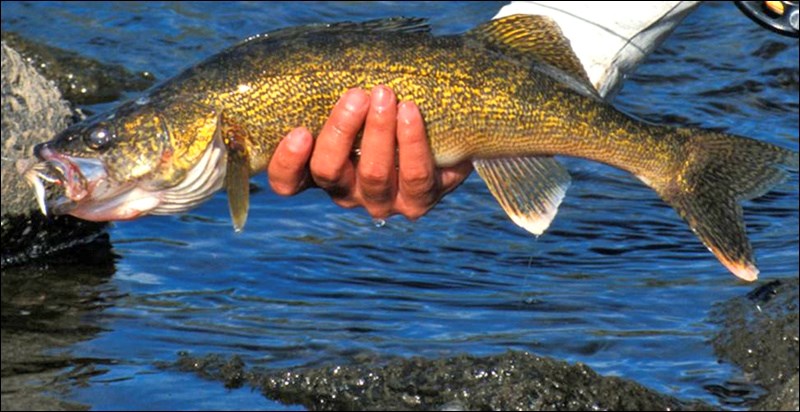Walleye is by far Saskatchewan’s most popular sport fish. People come from all over North America to catch walleye in our province’s clean cool waters. Some of the best walleye fishing can be found in northern lakes, but southern lakes such as Rafferty Reservoir, Last Mountain Lake, Diefenbaker Lake and, of course, the extremely popular Tobin Lake are world class too.
I know my kids love nothing more than to go out and catch walleye off the shore at one of the many fishing holes I have discovered during my time as a conservation officer. We don’t even keep any of the fish, as they just like to catch them. As a dad, there is no better quality time with my kids than fishing.
For me, this started at an early age when my family went to Jan Lake in early July. We used to catch walleye with a new jig called a Mr. Twister. Back then, the limits were more liberal, with the daily limit for walleye being eight and the possession limit being twice the daily limit.
Today, the limit of walleye is four, unless otherwise listed with the daily limit as a possession limit.
Back then, my dad used to call walleye pickerel. Well monkey see, monkey do. And I called them the same until I went to school to be a conservation officer and learned that we do not have pickerel in Saskatchewan. True pickerel are found in southeast Manitoba and Ontario, and look like a small northern pike.
Pickerel is just a slang name for walleye. The walleye is probably the most popular of edible fish in Saskatchewan, although the burbot, if you have not tried it, is a very close second in taste.
The walleye is named for its pearl-coloured eyes, caused by a reflective layer of pigment in the eye that helps them see and feed at night and in murky waters. They are not fans of the light and often go to deeper waters during the light of the day and then come closer to shore to feed during the night. Walleye are predators and will eat a variety of food including insect larvae, crayfish, frogs, minnows and forage fish.
I did not know this until I referred to one of my old textbooks, but it is believed walleye see only green and red due to lack of blue and yellow pigments in the eyes. This may be something you consider when picking a lure this summer.
There is another fish that looks similar to the walleye, the sauger. The one difference between the sauger and the walleye is the fact that the walleye’s caudal fin (tail fin) has a white spot on the bottom part of the fin. Sauger do not have this white patch.
Sauger are most commonly found in more northern waters.
Walleye are covered with unique rough feeling scales called ctenoid scales. One end of the scale has sharp teeth on it like a comb, while the other end is rounded and overlaps to make the fish flexible in water. This is why the scales of the walleye feel rough compared to northern pike scales.
Anyone who has caught a walleye knows to be wary of the mouth, dorsal fin and the gill plate. The mouth is full of sharp teeth and the gill plate, which covers the gills, has a sharp.
Lastly, we all have discovered the end result of improperly picking up a walleye with our bare hands. Doing this incorrectly will result in you leaking precious blood from one, or more punctures generated by stiff and sharp spines on the walleye dorsal fin.
To properly hold a walleye for that great photo it is best to use two hands – one to support the tail and the other under the belly of the fish.
Catching a walleye can be tougher than woodpecker lips. Those who think that you can just go out and get their limit are sadly mistaken, or have a favourite hole they should tell no one about. I know fishermen who say goodbye to their significant others early Saturday morning and are not seen until Sunday night. Walleye can stymie the most prolific angler with its moody feeding tendencies and placement in unpredictable habitat and depths.
Walleye are natural spawners. In many lakes, females are capable of laying up to several hundred thousand eggs per year. This is why it is important to protect these large spawning females in April and early May.
Southern lakes are productive with lots of feed for the hungry walleye. However, many of these lakes do not have the habitat to support natural reproduction. Because of this, the province has a hatchery program that stocks walleye fry into a number of these lakes where walleye cannot reproduce, and greatly increase the number of lakes we can catch these fish in.
Other interesting walleye facts include:
• The lips of a walleye have thousands of taste buds on them.
• Walleye are actually members of the perch family.
• Saskatchewan’s provincial fish is the walleye.
• Walleye can travel up to 50 kilometres in one night in search of food.
Until next time, keep your rod tip up!
— Ministry of Environment conservation officer Lindsey Leko has spent more than 26 years as a conservation officer in Saskatchewan. For many years, Leko contributed a column to local papers on a variety of issues related to hunting, fishing, and other resource-related issues. If you have questions, please contact lindsey.leko@gov.sk.ca.
Handle walleye with care after catching, as their sharp dorsal fins, spiny gill cover and sharp teeth can lead to puncture wounds. Ministry of Environment photo



